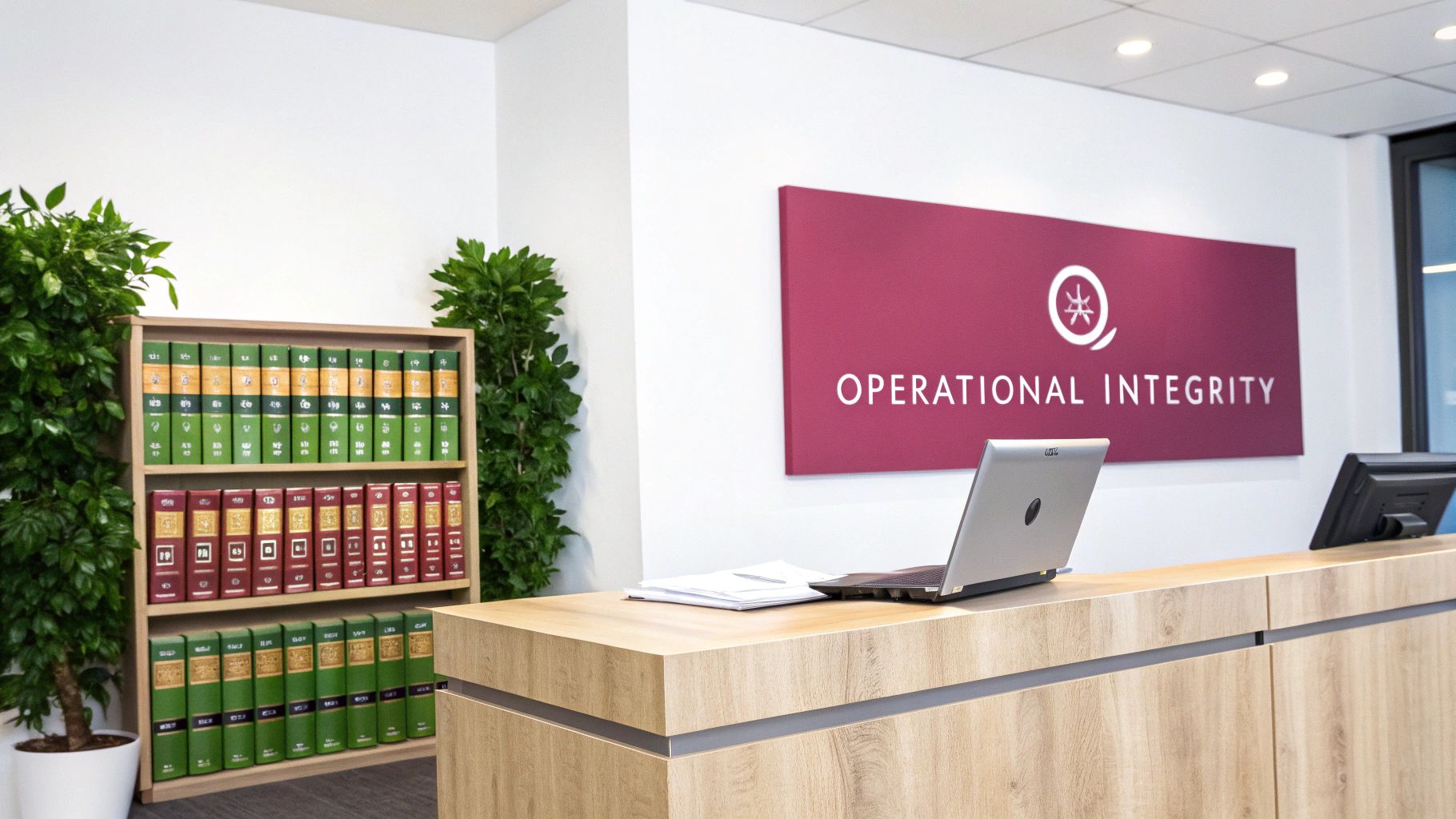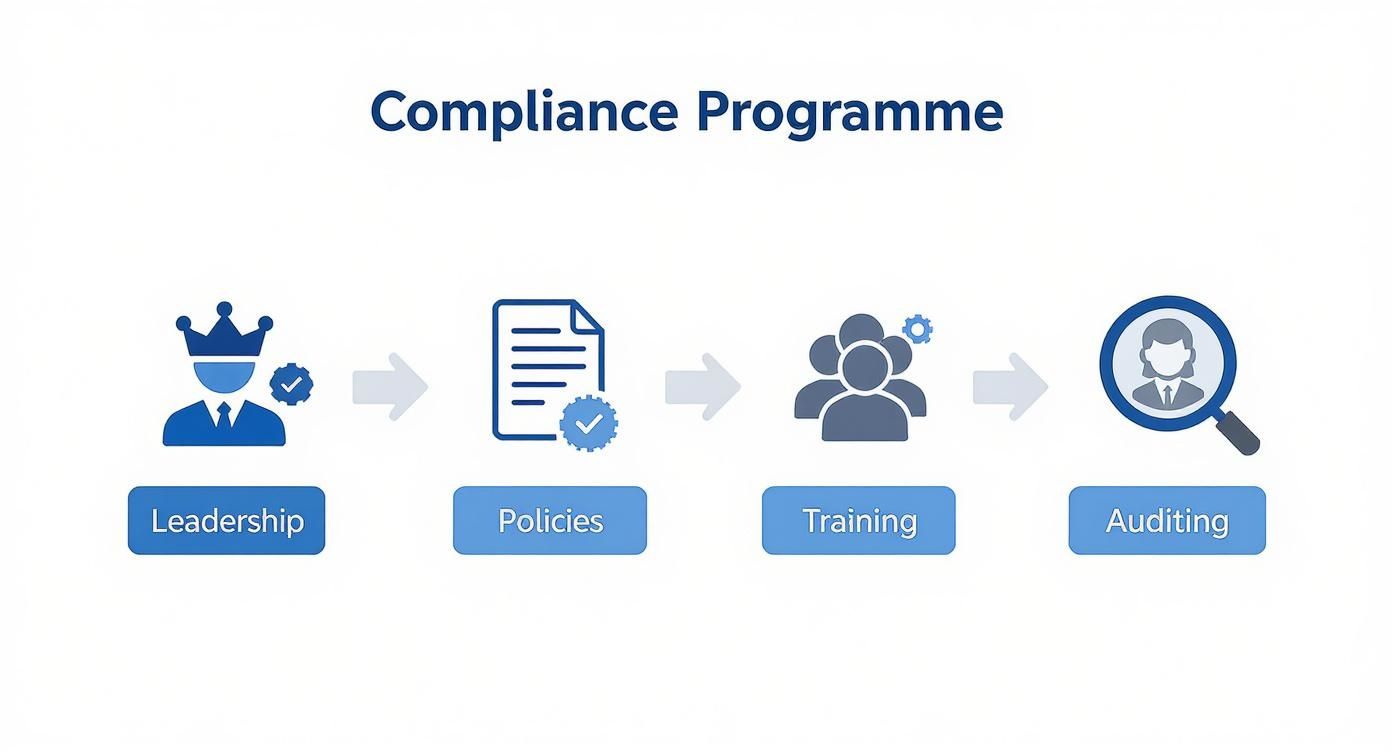What Is Compliance Management Explained
At its heart, compliance management is the process a company puts in place to make sure it's playing by the rules. It’s the practical framework for operating ethically and following all the laws, regulations, and industry standards that apply to your business.
This isn't just about abstract legal duties; it's about translating those requirements into tangible, everyday actions. For instance, a wealth management firm in London must translate the Financial Conduct Authority's (FCA) complex regulations on client suitability into a clear, repeatable process for every financial advisor to follow when giving advice.
Defining Compliance Management in Business

It’s helpful to think of compliance management not as a burden, but as the very scaffolding that keeps your company strong and stable. It’s a continuous cycle: you identify the rules you need to follow, create policies to meet those obligations, and then keep a close eye on your operations to make sure everyone is sticking to the plan.
For a professional services firm, this might mean handling client data strictly according to GDPR. For a financial advisor, it’s about ensuring all advice given meets the standards set by the Financial Conduct Authority (FCA). The end goal is to weave compliant behaviour so deeply into your company culture that it becomes second nature.
The Strategic Importance of Compliance
A well-run compliance programme is far more than a defensive measure to avoid fines—it’s a genuine strategic asset. When you demonstrate a solid commitment to compliance, you build trust with clients, partners, and investors. That trust is the bedrock of sustainable growth.
Navigating the UK's complex web of rules is no small feat, though. A revealing statistic shows that 69% of UK CEOs feel the constantly changing regulatory landscape hampers their ability to innovate and create value. On top of that, compliance costs in the financial services sector alone are climbing by around 12% each year.
A strong compliance framework moves a business from a reactive, "box-ticking" mindset to a proactive strategy that anticipates and mitigates risk. It becomes a key differentiator in a competitive market, showing clients their interests are protected.
To better understand how businesses tackle these challenges, this guide on risk compliance management offers some great perspectives on turning regulatory obligations into a business advantage.
Why Effective Compliance Isn't Just a Box-Ticking Exercise
It's easy to fall into the trap of seeing compliance as a necessary evil—a cost centre that just drains resources. But that's a short-sighted and frankly dangerous view for any modern UK business. Think of it less as a restrictive rulebook and more as the bedrock of your company's stability and growth. Get it wrong, and you're not just risking a fine; you're exposing the entire business to serious harm.
The numbers paint a stark picture. Recent figures show that 19% of UK compliance professionals admit their organisations have been hit with legal or regulatory action in just the last three years. The financial hit from data breaches tied to poor compliance is also eye-watering, adding an average of nearly £175,000 to the cost of a breach. For professional services firms, these aren't just abstract stats; they're a warning, as highlighted in these policy management and compliance insights.
From Defensive Play to Strategic Advantage
Beyond simply keeping the regulators at bay, a solid compliance framework is a powerful tool for building your business. It's how you earn and keep the trust of your clients. When customers feel confident that their data and interests are protected by robust, professional standards, you create a foundation for real, lasting loyalty.
Imagine a small accountancy firm in Manchester that let a critical Anti-Money Laundering (AML) update slip through the cracks. It seemed like a minor oversight until a routine audit brought it to light. The firm was slapped with a hefty fine, but the real damage came from the intense regulatory scrutiny that followed, disrupting their work and tarnishing their name locally. A structured approach to compliance would have prevented the entire mess.
Shifting your mindset on compliance changes everything. It stops being a reactive, fear-driven chore and becomes a proactive strategy that sharpens your entire operation. It drives efficiency, clarifies decision-making, and ultimately gives you a real edge over the competition.
Building Real Value Through Compliance
When compliance is woven into the very fabric of your company culture, it fosters integrity and accountability from the top down. This isn't just about feeling good; it translates directly into tangible business value.
Here’s how:
- Boosts Your Reputation: A clear commitment to ethical practices and following the rules builds a rock-solid, trustworthy brand that clients and partners want to be associated with. For example, an architectural practice known for its rigorous adherence to building regulations and planning laws will attract more prestigious and high-value projects.
- Makes You More Efficient: With standardised compliance processes, you eliminate the guesswork. Workflows become smoother and more predictable right across the business. Consider a law firm that standardises its client onboarding process to meet 'Know Your Customer' (KYC) requirements; this reduces errors and speeds up the time it takes to start billable work.
- Leads to Smarter Decisions: When your leadership team has a firm grasp of the regulatory landscape and its associated risks, they can make business decisions with far greater confidence.
The Core Components of a Compliance Programme
A solid compliance management system isn’t just a dusty policy document or a single checklist. It’s a living, breathing framework made up of several interconnected parts. While each piece has its own job to do, they all work together to build a culture of integrity and shield the business from risk. When you get these elements right, compliance simply becomes part of how you operate.
For any professional services firm, this structure is the bedrock of your operations. It’s what builds client trust and keeps the business on a stable footing.
Leadership and Governance
Real compliance always starts at the top. It’s not enough for the leadership team to just sign off on a programme; they need to be its biggest champions. This sets the tone for the whole organisation, sending a clear message that ethical conduct and following the rules are non-negotiable.
Governance is the skeleton that gives this leadership its shape. It means setting up a clear chain of command for compliance issues, appointing a dedicated compliance officer or committee, and giving them the authority and resources to be effective. Think of a director at a financial advisory firm who makes compliance metrics a regular, standing item in every board meeting. This demonstrates to the entire firm that compliance is a core business priority, not just an administrative task.
Risk Assessment and Policies
You can't manage compliance if you don't know what you're up against. A risk assessment is the process you use to systematically find, analyse, and prioritise potential regulatory threats. This could be anything from uncovering weaknesses in how you handle client data to spotting potential conflicts of interest in how you deliver your services. For a marketing agency, this would involve identifying the risks associated with using client data for campaigns under GDPR and PECR (Privacy and Electronic Communications Regulations).
Once you know where the risks are, you can build clear Policies and Procedures to manage them. These are the practical, day-to-day rules that guide how your team behaves.
A well-defined policy isn't just a file that sits on a server. It's a clear, accessible guide that turns complex regulations into simple, straightforward actions. It answers the question, "What do I actually need to do in my job to stay compliant?"
For example, a law firm might create a detailed policy on handling client data after its risk assessment flags it as a major vulnerability. To make sure policies like this meet legal standards, our team has created a helpful GDPR compliance checklist to walk you through the key requirements.
Training and Monitoring
A policy is useless if no one knows it exists or understands how to follow it. This is where Training and Communication come in. Every single employee, from the newest hire to the most senior partner, must understand their compliance responsibilities. A practical example is mandatory annual data security training for all staff at an IT consultancy, complete with a test to ensure comprehension. Good employee education is fundamental to any successful compliance framework. You can explore an actionable guide to successful compliance training to see what an effective programme looks like.
Finally, Monitoring and Auditing closes the loop. This piece is all about regularly checking that your controls are actually working. It might involve internal audits of project files, spot checks on client communication records, or using software to flag unusual activity—whatever it takes to confirm that the entire compliance programme is doing its job and remains effective.
Your Step-by-Step Compliance Management Process
Think of compliance management not as a one-time task, but as a continuous cycle. It’s a lot like maintaining a good health and safety programme; you identify potential risks, put safeguards in place, and if something goes wrong, you figure out why to stop it from happening again. This methodical approach is what helps professional services firms stay on top of their obligations and build real resilience.
Following a clear, staged process is key. It takes those dense, abstract regulations and turns them into a practical, day-to-day framework that ensures no stone is left unturned.
This process flow shows you the core pillars of a solid compliance programme, from getting leadership on board to keeping a constant watch through auditing.

As you can see, each stage logically flows into the next. It creates a powerful, self-improving loop that reinforces a culture where doing things the right way becomes second nature.
The Five Stages of Compliance Management
A strong compliance management process can be broken down into five distinct, yet interconnected, stages. Adopting this model provides a thorough and repeatable way to manage your firm’s regulatory duties.
-
Identify Your Obligations: First things first, you need a complete picture of all the laws, regulations, and industry standards that apply to your business. For a UK-based accountancy firm, this means getting to grips with everything from GDPR and Anti-Money Laundering (AML) rules to the specific standards set by bodies like the ICAEW.
-
Assess the Risks: With your obligations mapped out, the next step is to figure out where your firm is most vulnerable. This involves a hard look at your current processes, holding them up against the rules to find any gaps. An engineering consultancy might discover weak spots in its project documentation process, which could lead to non-compliance with health and safety regulations like CDM 2015.
-
Implement Controls: Once you know the risks, it's time to put controls in place to manage them. This isn’t just about paperwork; it’s about creating clear policies, updating procedures, and sometimes bringing in new technology. A great example is introducing mandatory, role-specific cybersecurity training for all staff to minimise human error.
-
Monitor and Test: Controls are useless if they don't actually work. This stage is all about regular monitoring and internal audits to test how effective your measures truly are. You could, for instance, run periodic reviews of client files to check that your AML procedures are being followed to the letter every single time. A practical test could involve a 'mystery shopper' style audit on your client onboarding team.
-
Report and Remediate: Finally, you need to report on what you find and, crucially, take action. If monitoring uncovers a weakness, you need a remediation plan to fix the issue and stop it from recurring. For instance, if an audit reveals that junior consultants are saving sensitive client data on unencrypted laptops, the remediation plan would involve immediate training, policy reinforcement, and deploying encryption software across all devices. A vital part of this stage is having a robust data breach response plan ready to go, ensuring you’re fully prepared to handle any incident swiftly and effectively.
Bringing Compliance Management into the 21st Century with Technology

Let's be honest, trying to manage modern compliance with spreadsheets and email reminders is a losing battle. The days of manually chasing staff for training sign-offs and tracking regulations in endless Excel tabs are well and truly over. Technology has completely changed the game, turning compliance from a reactive, paper-pushing chore into a smart, strategic part of the business.
Forward-thinking firms are embracing dedicated compliance management software and integrated GRC (Governance, Risk, and Compliance) platforms. Think of these systems as a central command centre for all things compliance—a single place to manage policies, keep an eye on risks, and automate routine tasks. The result? Less time spent on admin, and a much lower risk of costly human error.
The Impact of Automation and AI
Remember the old way of handling a policy update? You'd send out a mass email, cross your fingers that people read it, and then spend weeks manually tracking who had (and hadn't) acknowledged the change. It was inefficient and riddled with gaps.
Now, picture a system that automatically sends out the new policy, nudges anyone who hasn't responded with gentle reminders, and then spits out a perfect, audit-ready report on demand. That’s what modern compliance tech does. Some of the key tools making this happen include:
- Automation Platforms: These handle the heavy lifting of policy distribution and training reminders.
- AI-Powered Monitoring: Smart systems can analyse internal communications to flag potential issues, like discussions that could suggest insider trading or inappropriate client advice.
- Cloud Solutions: They provide secure, scalable, and easily accessible storage for all your compliance data, making audits far less painful.
The real leap forward with technology is gaining a live, 360-degree view of your compliance status. You move from doing occasional spot-checks to having continuous oversight, which means you can get ahead of risks before they become problems.
Investing in the Right Tools
This shift isn't just a trend; it's a fundamental change, particularly in highly regulated UK sectors like financial services. A recent survey highlighted that 82% of financial services companies are increasing their spending on compliance technology. Why? Because they know it works.
Firms are finding that automation can slash the time it takes to respond to regulatory changes by a staggering 50%—a massive advantage when the rules can change so quickly. You can dig deeper into these compliance technology trends to see just how significant the impact is.
Common Compliance Questions Answered
If you're grappling with the practicalities of compliance management, you're not alone. It's a topic that brings up a lot of questions for business leaders. Here are some clear, straightforward answers to the queries we hear most often from professional services firms.
What's the Difference Between Compliance and Risk Management?
It's easy to see why people often mix these two up, but they really are two sides of the same coin, each with a distinct job.
Think of compliance management as playing by the rules of the game. It’s all about adhering to the specific external laws, regulations, and industry standards you have to follow. A great example is a law firm needing to comply with the SRA (Solicitors Regulation Authority) rules on handling client money. It’s non-negotiable.
Risk management, however, is about looking at the entire playing field. It’s a much broader practice of spotting, evaluating, and dealing with any potential threat to your business. This could be a regulatory slip-up, but it also covers operational issues like a key person leaving, a financial downturn, or a major IT disaster. Compliance risk is a crucial piece of the overall risk puzzle, but risk management looks at the bigger picture.
How Can a Small Business Start a Compliance Programme?
Starting a compliance programme doesn't need to be a massive, expensive undertaking. The trick is to start small and focus on what really matters first.
- Identify Your Core Obligations: Begin by figuring out the most critical regulations that apply to your business. For almost any UK firm, this will mean getting to grips with GDPR, health and safety rules, and employment law.
- Do a Quick Risk Assessment: Where are your biggest weak spots? Have a frank conversation with your team. Is it how you’re storing client files? The way you handle payments? Pinpoint the areas of greatest vulnerability.
- Write Down Some Basic Policies: You don't need a hundred-page manual. Just create simple, clear procedures for those high-risk areas you've identified. For example, a one-page 'Data Handling' policy can set clear expectations for staff and is a fantastic starting point. This gives you a solid foundation to build on as your business grows.
For a small business, the goal isn't to achieve perfection on day one. It's about showing you're making a genuine, proactive effort to understand and meet your most important legal duties. That's the perfect starting point.
What Are the First Steps for Bringing in Compliance Software?
When you’re ready to introduce compliance software, a little prep work goes a long way. The first steps are all about setting yourself up for a smooth transition. Start by getting crystal clear on what you want to achieve—is the main goal to automate training reminders, or is it to make sure everyone has seen the latest policy update?
Next, take a look at your current processes and map them out. This helps you see exactly where the software will have the biggest impact. And finally, get your key people on board early. Their support is absolutely essential if you want the new system to be adopted successfully across the firm.
At SES Computers, we provide robust IT support and cybersecurity services that help businesses in Dorset, Somerset, and beyond meet their regulatory compliance needs. From securing sensitive data to ensuring system resilience, we build the technological foundation for your compliance framework. Discover how our managed IT solutions can support your business.